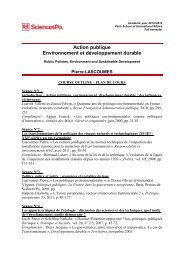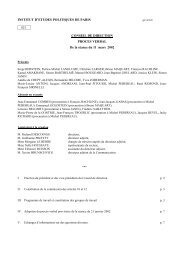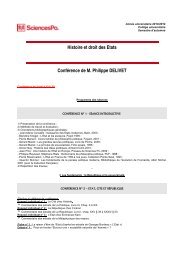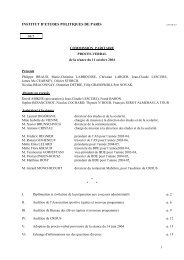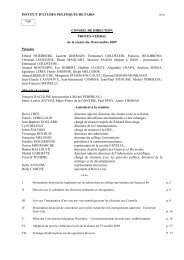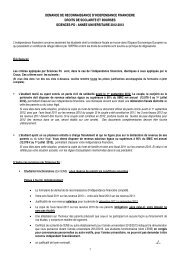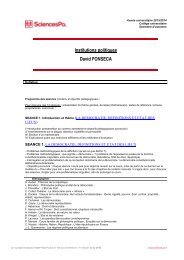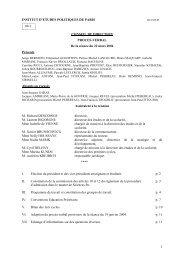ACCOUNTANCY Arthur SUSSMANN - Sciences Po
ACCOUNTANCY Arthur SUSSMANN - Sciences Po
ACCOUNTANCY Arthur SUSSMANN - Sciences Po
Create successful ePaper yourself
Turn your PDF publications into a flip-book with our unique Google optimized e-Paper software.
<strong>Arthur</strong> Sussmann<br />
arthur.sussmann@sciences-po.org<br />
Mobile phone: 06 42 97 18 93<br />
<strong>ACCOUNTANCY</strong><br />
<strong>Arthur</strong> <strong>SUSSMANN</strong><br />
Introduction to the basics of Finance & Accounting 1<br />
Fall semester 2012<br />
INTRODUCTION: Functions and main principles of Accounting & Finance<br />
SESSION 1: Financial statements (1/3): The balance sheet<br />
SESSION 2: Financial statements (2/3): The income statement<br />
SESSION 3: Financial statements (3/3): The cash flow statement & Time value of money<br />
SESSION 4: Financial analysis (1/2): introduction to the tools of strategy<br />
SESSION 5: Financial analysis (2/2): from margin analysis to profitability analysis<br />
SESSION 6: Mid-term<br />
SESSION 7: The notion of risk in finance – The Capital asset pricing model<br />
SESSION 8: The share value & the stock market analysis method<br />
SESSION 9: The capital increase & the cost of capital<br />
SESSION 10: Leverage Buy Out & Restructuring<br />
SESSION 11: Consolidation methods & Off-balance sheet commitments<br />
SESSION 12: What is a firm value? Understanding the limits of Finance.<br />
Bibliography<br />
Vernimmen Pierre, Corporate Finance: Theory & Practice, Dalloz, 2012<br />
Vernimmen Pierre, Finance d’entreprise, Dalloz, 2013<br />
www.vernimen.net<br />
Année universitaire 2012/2013<br />
1 ère année Master Droit Economique<br />
semestre d’automne<br />
1 Notice that this schedule is not binding: changes of any kind can be made all along the semester, including the date<br />
of the exams and the content of the working program.
Class Schedule<br />
INTRODUCTION & SESSION 1<br />
Functions and main principles of Accounting & Finance – The balance Sheet<br />
Key words: Financial statements, balance sheet, double entry accounting, assets, fixed assets, intangible<br />
assets, liabilities, equity, debt, resources, uses, operating assets, debit, credit, immobilizations, Gearing<br />
ratio, Net debt, Accounting Principles, IFRS, GAAP, IASB<br />
SESSION 2<br />
Financial statements (2/3): The income statement<br />
Key words: P&L, margins, income statement, expense, charges, costs, sales, revenues, gross margin,<br />
EBITDA, EBIT, Net income, Earning before taxes, profit<br />
Presentations:<br />
-‐ The main principles of accounting<br />
-‐ What is amortization?<br />
Memos:<br />
-‐ Operating Assets<br />
-‐ Fixed assets<br />
-‐ IFRS & US GAAP<br />
-‐ Expenses vs. investments: what is the difference?<br />
-‐<br />
SESSION 3<br />
Financial statements (3/3): The cash flow statement & Time value of money<br />
Key words: rate of return, time value of money, present value, net present value, NPV rule, investment<br />
decision, interest rate, business plan, discount rate, cash flow statement, opportunity cost, DCF formula,<br />
perpetuity, capital expenditures<br />
Case<br />
Presentations:<br />
-‐ What is the value of money?<br />
-‐ “Cash is king!”: Explain.<br />
Memos:<br />
-‐ Time value of money<br />
-‐ The income statement: definition, structure and uses<br />
-‐ Inventory & inventory changes account<br />
-‐ Free cash flows<br />
SESSION 4<br />
Financial analysis (1/2): introduction to the tools of strategy<br />
Key words: <strong>Po</strong>rter analysis, SWOT, Margin analysis, PESTEL, market share, volume effect, price effect, mix<br />
effect, internal growth, external growth, fixed costs, variable costs, contribution margin<br />
Presentation:<br />
-‐ Financial analysis: Apple<br />
-‐ What could the collapse of a firm’s turnover mean?<br />
Memos:<br />
-‐ <strong>Po</strong>rter analysis: use and limits<br />
-‐ Product life cycle<br />
-‐ Contribution margin<br />
2
SESSION 5<br />
Financial analysis (2/2): from margin analysis to profitability analysis<br />
Key Words: Permanent Working Capital, Working capital per day, inventory turnover, gearing ratio, liquidity,<br />
net debt, gearing, leverage, break-even point<br />
Presentations:<br />
-‐ What is the different between profitability ratios & margins analysis?<br />
Memos:<br />
-‐ Break- even point: definition and use<br />
-‐ ROCE & ROE<br />
-‐ The leverage<br />
SESSION 6<br />
Mid-term<br />
In addition to the Exam, this Session could be used as a back-up session.<br />
SESSION 7<br />
The notion of risk in finance – The Capital asset pricing model<br />
Key words: financial markets, CAPM formula, Bêta, market efficiency, risk, risk premium, variance, Risk free<br />
asset<br />
Presentations:<br />
-‐ What are the main functions of financial markets?<br />
-‐ Is there a specific level of profitability required by financial markets?<br />
Memos:<br />
-‐ Bêta<br />
-‐ Capital asset pricing model (CAPM) formula: risk premium and risk free asset<br />
-‐ The theory of efficient markets and the notion of arbitrage (market imperfection)<br />
SESSION 8<br />
The share value & the stock market analysis method<br />
Key words: stakeholder, shareholder, market capitalization, market value, share, bond, EPS, PER, dividend,<br />
PBR, Free float, Dividend per share, Dividend, Stock market analysis<br />
Presentations:<br />
-‐ Stock market analysis of LVMH<br />
-‐ Stock market analysis of Société Générale<br />
Memos:<br />
-‐ PER<br />
-‐ Dividend & Dividend policy<br />
-‐ Share vs. Bond<br />
SESSION 9<br />
The capital increase & the cost of capital<br />
Key words: Capital increase, Pre-emptive subscription right, Real dilution effect, apparent dilution effect, call<br />
option, value of the subscription right, TERP, WACC, Theory of signal, Earnings per share, Signaling theory,<br />
value creation, Hybrid securities.<br />
Presentations:<br />
-‐ The mechanisms of capital increase<br />
-‐ Presentation: What is a successful capital increase?<br />
-‐<br />
3
Memos:<br />
-‐ The signaling theory<br />
-‐ WACC<br />
-‐ Hybrid securities<br />
-‐ The pre-emptive subscription rights<br />
-‐ Capital decrease<br />
SESSION 10<br />
Leverage Buy Out & Restructuring<br />
Special guests: Me Mathieu Della Vittoria & Me François Kopf, Scotto & Associés<br />
Key words: parent company regimes, holding, hedge funds, Mezzanine debt, subordinated debt, junior debt,<br />
senior debt<br />
Cases<br />
Memos:<br />
-‐ The parent company regime (in France)<br />
-‐ Debt structure: junior, senior & mezzanine debt<br />
SESSION 11<br />
Consolidation methods & Off-balance sheet commitments<br />
Key words: consolidation, off-balance sheet commitments, minority interests, equity methods, proportional<br />
integration, full integration, notes to the accounts, contingent asset, contingent liabilities<br />
Presentations:<br />
-‐ The mechanisms of ENRON collapse<br />
Memos:<br />
-‐ Consolidations methods<br />
-‐ The notes to the accounts<br />
-‐<br />
SESSION 12<br />
What is a firm value? Understanding the limits of Finance.<br />
Key words: Multiples methods, Market multiples, Transaction Multiples, direct method, indirect method,<br />
valuation by discounted cash flows, terminal value, peer group comparison, sum-of-the-parts method, net<br />
asset value, premiums<br />
Presentation:<br />
-‐ How could you assess the value of a firm?<br />
-‐ The mechanisms of the subprime crisis<br />
Memos:<br />
-‐ Multiples method<br />
4
Introduction to the basics of accounting & finance<br />
Fall semester 2012<br />
ASSESSMENT CHART<br />
Assessment will include both written and oral exercises based on <strong>Sciences</strong> <strong>Po</strong> & basic business<br />
requirements. The aim of the assessment method is to provide a fair view of students’ involvement,<br />
contributing to make them familiar with basic notions in finance. In order to reflect as much as possible<br />
students’ real involvement and skills, 60% of the grade will depend on written exams while 40% of the grade<br />
will depend on oral presentation and homeworks. Grades will be mostly based on criteria mentioned in the<br />
Assessment grid available on <strong>Sciences</strong> <strong>Po</strong> ENTG.<br />
1. Grading<br />
2. Exercises description<br />
a. Oral presentation<br />
As in business life, the main objective of this exercise is to train students to perform oral<br />
presentation in a limited period of time. To do this, <strong>Sciences</strong> <strong>Po</strong> basic requirements in terms of<br />
oral presentation are fully applicable. Such exercise should contribute to develop students’<br />
communication, analytical and team skills.<br />
Requirements are detailed in the Assessement grid available on <strong>Sciences</strong> <strong>Po</strong> ENTG. Notice that<br />
the presentation topic is closely tied to the content of the class.<br />
ü� As in business life, <strong>Po</strong>wer <strong>Po</strong>int shall be used as a support for the students’<br />
presentation. Students could also use any kind of documents: tables, diagrams, press<br />
articles etc.<br />
ü� As in business life, students shall work in team (2 or 3 people).<br />
ü� According to <strong>Sciences</strong> <strong>Po</strong> basic requirements, and as in business life, the presentation<br />
shall not exceed 10 minutes.<br />
ü� In order to make their presentation available to other students, a full written transcript<br />
of the presentation will have to be communicated to the lecturer the day of the<br />
presentation. Then, students shall post their transcript and documents in the class<br />
ENTG.<br />
5
3. Press Review<br />
The press review aims at underlying the link between the course theoretical approach and business<br />
life. Students shall select event or situation found in economic and financial newspapers, highlighting<br />
financial or accounting mechanisms. Press Review shall be lively. This exercise shall contribute to<br />
develop analytical, oral and team skill.<br />
ü� Students shall work in group of 2 or 3.<br />
ü� Press Review shall not exceed 10 minutes.<br />
ü� Documents used shall be posted on <strong>Sciences</strong> <strong>Po</strong> ENTG<br />
4. Memo – « Fiche technique »<br />
The Technical Memo / « Fiche technique » is a usual exercise characterizing <strong>Sciences</strong> <strong>Po</strong> teaching<br />
method. The aim of the exercise is two write a short and accurate paper dealing with a basic notion.<br />
The student shall grasp a deep understanding of the notion before making a short, exhaustive and<br />
well organized paper covering the scope. The Technical Memo must be clear enough to be used for<br />
the revision of other students that are not familiar with the notion. This exercise shall contribute to<br />
develop analytical and writing skills.<br />
Requirements are detailed in the Assessment grid available on <strong>Sciences</strong> <strong>Po</strong> ENTG.<br />
ü� The Memo shall not exceed 2 pages (Times New Roman, 12).<br />
ü� The Memo shall be returned to the lecturer the day planned in the class Schedule and<br />
posted on the class ENTG to be available to other students<br />
ü� Plagiarism will not be accepted. Quotations and sources shall be mentioned.<br />
ü� The Memo shall be accurate.<br />
ü� The Memo shall be well structured and easy to read in order to be used as learning tool<br />
for other students. Bullet points may be used.<br />
ü� Students shall take care to the form of the Memo.<br />
6
ASSESSMENT GRID<br />
Grade Comments<br />
A 20 - 18<br />
B 18-16<br />
C 16-14<br />
D 14-12<br />
E 12-10<br />
§� Outstanding work: the requirements of the course<br />
were fully met. In addition, student has shown great creativity in his<br />
work.<br />
§� Very good work: the requirements of the course<br />
were fully met.<br />
§� The presentation was cleverly structured including<br />
a compelling introduction highlighting what was at stake and defining<br />
the main key words. The conclusion shows that the topic of the<br />
presentation was fully understood.<br />
§� Perfect command of the key ideas. The content is<br />
relevant including telling examples covering the entire scope. The form<br />
of the presentation is perfectly clear and easy to understand for the<br />
attendance, without exceeding the allocated time resource. Notions are<br />
accurate and well explained.<br />
§� Relevant documents were available and useful to<br />
follow the presentation. <strong>Po</strong>wer <strong>Po</strong>int was used for the presentation.<br />
Appropriate diagrams and tables were used and commented.<br />
Bibliography was provided and main sources were indicated. Transcript<br />
of the presentation was available and communicated to the lecturer.<br />
§� Good Work: the requirements of the course were<br />
met although minor points could be improved.<br />
§� The presentation was well structured including<br />
relevant introduction and conclusion. Key notions were accurately<br />
defined.<br />
§� Expectations regarding the scope of the<br />
presentation were met. Good examples were provided to sustain<br />
students’ points.<br />
§� Oral presentation was clear and easy to follow.<br />
The presentation did not exceed the allocated time resource.<br />
§� Documents were available and used for the<br />
presentation. Transcript was available and communicated to the<br />
lecturer<br />
§� Satisfactory: the requirements of the course were<br />
met although some points deserve a higher involvement.<br />
§� The structure of the presentation is acceptable.<br />
Introduction and conclusion briefly define the main notions.<br />
§� The scope was mostly covered although some<br />
points could have been included in the presentation. Some examples<br />
were used. Key ideas and notions were understood.<br />
§� Documents were available and correctly used.<br />
Transcript was available and communicated to the lecturer.<br />
§� Partially Satisfactory: the requirements of the<br />
course are almost met or partially met. Nevertheless, more work is<br />
needed to reach class expectations.<br />
§� Presentation was structured although it was not<br />
clear enough. Structure could be more relevant though. Introduction is<br />
available but it could be improved especially regarding the quality and<br />
the accuracy of the definitions.<br />
§� Key ideas have been more or less understood<br />
although compelling examples were not necessarily provided.<br />
§� Oral presentation suggested superficial command<br />
of the subject and may have been characterized by a lack of clarity.<br />
Time requirements were not met.<br />
§� The quality of the documents provided is fair<br />
although it was not fully integrated to the presentation. Transcript is<br />
7
F / FX >10<br />
roughly reliant.<br />
§� Case 1: Student failed to reach some of the basic<br />
requirements of the class both in terms of form and content. A much<br />
higher involvement of the student is needed.<br />
Case 2: Presentation is not available.<br />
Case 3: Plagiarism (FX)<br />
§� Structure of the presentation is not relevant or<br />
even available. Key ideas were not defined and / or correctly<br />
understood.<br />
§� The scope of the presentation was not really<br />
covered. Key ideas were not properly understood. Examples were not<br />
provided.<br />
§� Standards in terms of form were not met either.<br />
Time requirements were not reached.<br />
§� Documents were poor and transcript was not<br />
available or is not reliant.<br />
Introduction to the basics of accounting & finance<br />
Fall semester 2012<br />
ASSESSMENT FORM 2<br />
Date Name Title of the presentation<br />
Structure<br />
of the<br />
presentation<br />
Form<br />
of the<br />
presentation<br />
Content<br />
of the<br />
presentation<br />
Relevance<br />
of the<br />
structure<br />
Scope<br />
covered by<br />
the<br />
presentation<br />
Other<br />
Length<br />
Clarity<br />
Quality of<br />
the supports<br />
Accuracy<br />
Introduction<br />
&<br />
Definitions<br />
2 Assessment is based on the criteria provided in the assessment grid available on <strong>Sciences</strong> <strong>Po</strong> ENTG.<br />
8
Examples<br />
provided<br />
Diagrams &<br />
Tables<br />
A 20-18 Comments:<br />
B 18-16<br />
C 16-14<br />
D 14-12<br />
E 12-10<br />
F > 10<br />
9



